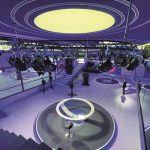LED lighting continues to prove its popularity and effectiveness in filmmaking, broadcasting environments and television production. The wider adoption of LED lighting in production will continue to evolve due to technological advances and innovation LED lighting continues to make its mark in broadcasting, television production and filmmaking, and since its introduction to the market, the […]
LED lighting continues to prove its popularity and effectiveness in filmmaking, broadcasting environments and television production. The wider adoption of LED lighting in production will continue to evolve due to technological advances and innovation
 LED lighting continues to make its mark in broadcasting, television production and filmmaking, and since its introduction to the market, the humble LED light has evolved into a high quality alternative to traditional lighting options. The art of lighting in film and television is universally understood it creates moods and atmosphere and is a vital constituent of every scene. LED has adapted well to these environments while bringing much needed benefits into the mix, such as cost-effectiveness due to the long lifespan with no bulb replacements, and energy efficiency of the LED (in some instances LEDs use up to 85% less energy than tungsten lights). Other benefits include less heat generation, which translates into greatly reduced cooling costs and shorter strike times, and innovative features such as remotely controlled internal dimming, focus and colour adjustment.
LED lighting continues to make its mark in broadcasting, television production and filmmaking, and since its introduction to the market, the humble LED light has evolved into a high quality alternative to traditional lighting options. The art of lighting in film and television is universally understood it creates moods and atmosphere and is a vital constituent of every scene. LED has adapted well to these environments while bringing much needed benefits into the mix, such as cost-effectiveness due to the long lifespan with no bulb replacements, and energy efficiency of the LED (in some instances LEDs use up to 85% less energy than tungsten lights). Other benefits include less heat generation, which translates into greatly reduced cooling costs and shorter strike times, and innovative features such as remotely controlled internal dimming, focus and colour adjustment.
In the past, there was the perception that LED lighting could not match traditional lighting in terms of quality and output. Initially, there may have been some truth to that statement but with the advances in LED technology, these lights are exceeding the quality benchmarks for colour temperature and performance.
Traditionally, light fixtures have been measured using the colour rendering index (CRI). This index was developed over 40 years ago and was originally designed to test the colour accuracy of tungsten lamps. A CRI of 100 indicates perfect daylight quality, and many LED fixtures on the market claim high CRI values in the 90s. However, this can be misleading due to the fact that the measurement is actually an average of just eight colour samples. There are some LEDs in the market that reproduce good performance in these eight colour samples and high CRI numbers, but do not generate all the colours in the visible spectrum. The better LED fixtures have good CRI numbers but also produce a continuous spectrum of light. This can be seen by how accurately skin tones are reproduced to the human eye or camera.
So what separates one LED lighting manufacturer from another? It all starts with how an LED is manufactured. Manufacturers work closely with leading suppliers to select the highest quality LEDs that meet the specific colour and output requirements.
Low cost, off-the-shelf LEDs or those bought from a catalogue simply do not produce the correct or consistent colour. As a result, LED lights for use in film and television applications must be manufactured and selected to very tight standards, ensuring that the end result exceeds customer expectations and helps to produce high-quality images.
A high performing 5mm LED package comprises a series of components that must be manufactured to the highest quality standards, including the LED die, phosphors and structural materials. In addition, the tightest quality control processes need to be in place to ensure that manufactured LEDs do, in fact, measure up. Ideally, these processes should take place at the manufacturing stage, and again after assembly, where the final photometrics testing must be completed.
Other components of the common 5mm LED package include the actual LED chip, the anode and cathode post and, perhaps, most importantly for this application, the lens. The lensing of an LED must be flawless as it has an effect on the light beam patterns, which must be consistent. It also needs to ensure smooth fall offs, and that there are no chromatic aberrations. Manufacturers go as far as to custom mould the LED lens based on individual customer needs.
Contrary to popular belief, LED lights do indeed produce heat. However, the amount of heat generated is far less than traditional tungsten bulbs as the individual LED lights are much more efficient. Inside the small bubble of the LED is a phosphor coating which glows when stimulated and the greater the voltage differential between the phosphor and the base, the brighter the light that is emitted. The more LEDs that are used in panel type fixtures, the greater the amount of heat generated. Managing that heat is critical to maintaining the colour accuracy, and maximising the life expectancy of the LED. This is accomplished by not overdriving them through controlled current management, and designing the fixture with the proper thermal management, which include active or passive heat sinks.
LED Fresnels are still fairly new to the market and provide a more collimated light source than the previous LED panels. They offer more control and their traditional and familiar design makes them ideal for both studio and location applications. Recent breakthroughs in surface mount LED technology are now allowing for higher wattage LED emitters. These emitters produce intense heat in a concentrated area, and have in turn driven the need for breakthroughs in thermal management.
Thermal management should be a specific focus as it deserves particular attention during the design and manufacture process. Many different topologies may be used for heat exchange using convection, conduction or radiation. For Fresnel lighting the use of heat sink technology is most effective a combination of convection and radiation as a means to dissipate heat. In addition, the use of fans may be effective in blowing heat off the heat sink and moving it away from the LED. In the past, the use of fans was not an option due to noise and reliability concerns, but advancements in fan technology has seen the adoption of bearing-less, laminar blade fans into Fresnel lighting.
LED lighting continues to prove its popularity and effectiveness in filmmaking, broadcasting environments and television production. In addition to long-term cost-effectiveness and energy efficiency, LEDs offer inherent advantages to the human element of the industry gaffers, lighting technicians and on-screen talent. The wider adoption of LED lighting in this industry will, no doubt, continue to evolve due to technological advances and innovation so that it can deliver more benefits to applications and truly become the dominant force in entertainment lighting.
Chris Marchitelli is Marketing VP 
of Litepanels.
















































































